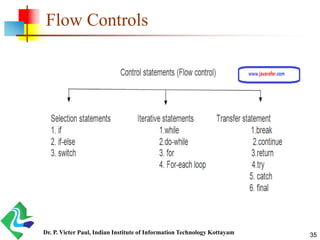Java - OOPS and Java Basics
- 1. OOPS and JAVA Dr. P. Victer Paul, Indian Institute of Information Technology Kottayam 1
- 2. Programming Language A programming language is a computer language programmers use to develop applications, scripts, or other set of instructions for a computer to perform specific tasks. The commonly used programming methodologies are: Procedural programming Object-oriented programming (OOP) Dr. P. Victer Paul, Indian Institute of Information Technology Kottayam 2
- 3. Procedural programming Involves dividing a large program into a set of sub- procedures or subprograms that perform specific tasks. Module consists of single or multiple procedures. Most of the data is shared as global that can be accessed from anywhere within the program. Dr. P. Victer Paul, Indian Institute of Information Technology Kottayam 3
- 4. Procedural programming Dr. P. Victer Paul, Indian Institute of Information Technology Kottayam 4
- 5. Difficulties in Procedural App Focus is on procedures All data is shared: no protection More difficult to modify Hard to manage complexity Dr. P. Victer Paul, Indian Institute of Information Technology Kottayam 5
- 6. Object Oriented programming an approach that provides a way of modularizing programs by creating partitioned memory area for both data and functions that can be used as template for creating copies of such modules on demand. Dr. P. Victer Paul, Indian Institute of Information Technology Kottayam 6
- 7. Advantages of OOP Real-world programming Reusability of code Modularity of code Resilience to change Information hiding Dr. P. Victer Paul, Indian Institute of Information Technology Kottayam 7
- 8. Procedural vs. Object-Oriented Procedural Withdraw, deposit, transfer Object Oriented Customer, money, account Dr. P. Victer Paul, Indian Institute of Information Technology Kottayam 8
- 9. Procedural vs. Object-Oriented S. No Procedural Programming Object-Oriented Programming 1 Emphasis on Procedures Emphasis on Data 2 Data is not hidden Data is hidden 3 Data and methods are separate Data and methods are combined using objects 4 Data can be accessed by external functions Data cannot be accessed by external functions 5 Top-down Approach in program design Bottom-up Approach in program design 6 Eg. C, PASCAL Eg. C++, JAVA, Smalltalk Dr. P. Victer Paul, Indian Institute of Information Technology Kottayam 9
- 10. OOP Concepts Objects Classes Data Abstraction Data Encapsulation Inheritance Polymorphism Dr. P. Victer Paul, Indian Institute of Information Technology Kottayam 10
- 11. JAVA James Gosling and Sun Microsystems Oak Java, May 20, 1995, Sun World HotJava The first Java-enabled Web browser Dr. P. Victer Paul, Indian Institute of Information Technology Kottayam 11
- 12. JAVA James Gosling, Mike Sheridan, and Patrick Naughton initiated the Java language project in June 1991. The small team of sun engineers called Green Team. Originally designed for small, embedded systems in electronic appliances like set-top boxes. Firstly, it was called “Greentalk” by James Gosling, and file extension was .gt. After that, it was called Oak and was developed as a part of the Green project. Dr. P. Victer Paul, Indian Institute of Information Technology Kottayam 12
- 13. JAVA According to James Gosling, “Java was one of the top choices along with Silk“. Java is an island of Indonesia where first coffee was produced (called java coffee). Notice that Java is just a name, not an acronym. In 1995, Time magazine called Java one of the Ten Best Products of 1995. Dr. P. Victer Paul, Indian Institute of Information Technology Kottayam 13
- 14. Java Milestones Year Development 1990 Sun decided to developed special software that could be used for electronic devices. A project called Green Project created and headed by James Gosling. 1991 Explored possibility of using C++, with some updates announced a new language named “Oak” 1992 The team demonstrated the application of their new language to control a list of home appliances using a hand held device. 1993 The World Wide Web appeared on the Internet and transformed the text-based interface to a graphical rich environment. The team developed Web applets (time programs) that could run on all types of computers connected to the Internet. Dr. P. Victer Paul, Indian Institute of Information Technology Kottayam
- 15. Java Milestones Year Development 1994 The team developed a new Web browsed called “Hot Java” to locate and run Applets. HotJava gained instance success. 1995 Oak was renamed to Java, as it did not survive “legal” registration. Many companies such as Netscape and Microsoft announced their support for Java 1996 Java established itself it self as both 1. “the language for Internet programming” 2. a general purpose OO language. 1997- A class libraries, Community effort and standardization, Enterprise Java, Clustering, etc.. Dr. P. Victer Paul, Indian Institute of Information Technology Kottayam
- 16. Sun white paper defines Java as: Simple and Powerful Safe Object Oriented Robust Architecture Neutral and Portable Interpreted and High Performance Threaded Dynamic Dr. P. Victer Paul, Indian Institute of Information Technology Kottayam 16
- 17. Java Attributes Familiar, Simple, Small Compiled and Interpreted Platform-Independent and Portable Object-Oriented Robust and Secure Distributed Multithreaded and Interactive High Performance Dynamic and Extensible Dr. P. Victer Paul, Indian Institute of Information Technology Kottayam 17
- 18. Overlap of C, C++, and Java C C++ Java Dr. P. Victer Paul, Indian Institute of Information Technology Kottayam 18
- 19. Java better than C++ ? No Typedefs, Defines, or Preprocessor No Global Variables No Pointers No Unsafe Structures No Multiple Inheritance No Operator Overloading No Automatic Coercions No Fragile Data Types Dr. P. Victer Paul, Indian Institute of Information Technology Kottayam 19
- 20. Object Oriented Languages -A Comparison Feature C++ Objective C Ada Java Encapsulation Yes Yes Yes Yes Inheritance Yes Yes No Yes Multiple Inherit. Yes Yes No No Polymorphism Yes Yes Yes Yes Binding (Early or Late) Both Both Early Late Concurrency Poor Poor Difficult Yes Garbage Collection No Yes No Yes Genericity Yes No Yes Limited Class Libraries Yes Yes Limited Yes Dr. P. Victer Paul, Indian Institute of Information Technology Kottayam
- 21. JDK Editions Java Standard Edition (J2SE) J2SE can be used to develop client-side standalone applications or applets. Java Enterprise Edition (J2EE) J2EE can be used to develop server-side applications such as Java servlets and Java ServerPages. Java Micro Edition (J2ME). J2ME can be used to develop applications for mobile devices such as cell phones. Dr. P. Victer Paul, Indian Institute of Information Technology Kottayam 21
- 22. JDK Versions JDK 1 (1995), JDK 1.2 (1998), JDK 1.3 (2000) JDK 1.4 (2002), JDK 1.5 (2004), JDK 6 (2006) JDK 7 (2011), JDK 12 (2019), JDK 13 (2019) Tools appletviewer (for viewing Applets) javac (Java Compiler) java (Java Interpreter) jdb (Java Debugger) Dr. P. Victer Paul, Indian Institute of Information Technology Kottayam 22
- 23. Java as Portable Unlike other language compilers, Java complier generates code (byte codes) for Universal Machine. Java Virtual Machine (JVM): Interprets bytecodes at runtime Dr. P. Victer Paul, Indian Institute of Information Technology Kottayam 23
- 24. Java as Portable Dr. P. Victer Paul, Indian Institute of Information Technology Kottayam 24
- 25. Total Platform Independence JAVA COMPILER JAVA BYTE CODE JAVA INTERPRETER Windows 95 Macintosh Solaris Windows NT (translator) (same for all platforms) (one for each different system) Dr. P. Victer Paul, Indian Institute of Information Technology Kottayam 25
- 26. Architecture Neutral & Portable Java Compiler - Java source code (file with extension .java) to bytecode (file with extension .class) Bytecode - an intermediate form, closer to machine representation A interpreter (virtual machine) on any target platform interprets the bytecode. Dr. P. Victer Paul, Indian Institute of Information Technology Kottayam 26
- 27. JAVA Program Structure Dr. P. Victer Paul, Indian Institute of Information Technology Kottayam 27
- 28. First JAVA Application /* Hello World, first application, only output. */ import java.io.*; public class Hello { public static void main (String [] args) { System.out.println(“Java Hello Worldn”); } //end main }//end class Dr. P. Victer Paul, Indian Institute of Information Technology Kottayam 28
- 29. How to get it running To compile: javac Hello.java To run: java Hello Note: Java is CASE SENSITIVE!! Whitespace is ignored by compiler File name has to be the same as class name in file. Need to import necessary class definitions Dr. P. Victer Paul, Indian Institute of Information Technology Kottayam 29
- 30. Java Path Setting On Error: Select Computer from the Start menu Choose System Properties from the context menu Click Advanced system settings > Advanced tab Click on Environment Variables, under System Variables, find PATH, and click on it. In the Edit windows, modify PATH by adding the location of the class to the value for PATH. Reopen Command prompt window, and run your java code. Dr. P. Victer Paul, Indian Institute of Information Technology Kottayam 30
- 31. JAVA Keywords abstract continue for new switch assert default goto package synchronized boolean do if private this break double implements protected throw byte else import public throws case enum instanceof return transient catch extends int short try char final interface static void class finally long strictfp volatile const float native super while Dr. P. Victer Paul, Indian Institute of Information Technology Kottayam 31
- 32. Primitive Data Types • Value of primitive type is not considered an object • java.lang provides wrapper classes for each of the primitive types Dr. P. Victer Paul, Indian Institute of Information Technology Kottayam 1-32
- 33. Java Data Types Sizes fully specified by Java standard. Java is a very strongly typed language Integer types int (4 bytes signed) short (2 bytes signed) long (8 bytes signed) use suffix L (eg 1000000000L) byte (1 byte signed) Floating-point types float (4 bytes) use suffix F (eg 1.28F) double( 8 bytes) Dr. P. Victer Paul, Indian Institute of Information Technology Kottayam 33
- 34. Operators Dr. P. Victer Paul, Indian Institute of Information Technology Kottayam 1-34
- 35. Flow Controls Dr. P. Victer Paul, Indian Institute of Information Technology Kottayam 35
- 36. End… Dr. P. Victer Paul, Indian Institute of Information Technology Kottayam 36

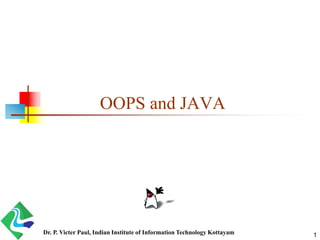
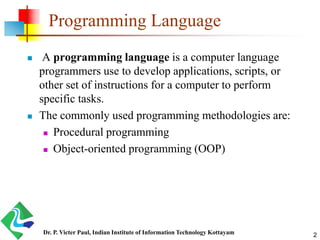

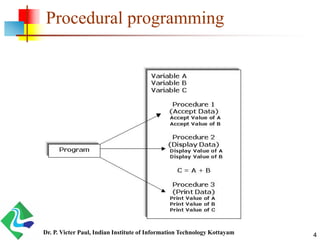
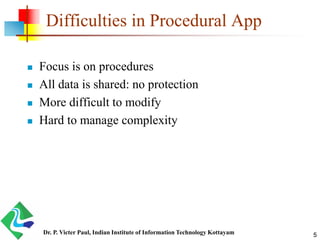





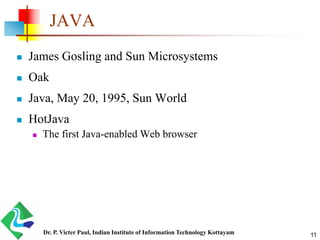















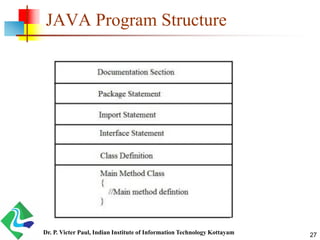
![First JAVA Application
/* Hello World, first application, only output. */
import java.io.*;
public class Hello
{
public static void main (String [] args)
{
System.out.println(“Java Hello Worldn”);
} //end main
}//end class
Dr. P. Victer Paul, Indian Institute of Information Technology Kottayam 28](https://image.slidesharecdn.com/java-oopsandjavabasics-200510151857/85/Java-OOPS-and-Java-Basics-28-320.jpg)






